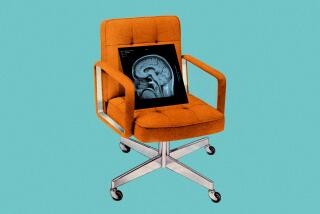Hunting for Brain Disorders : Attorneys Turn to UCI Scanner as Defense Tool
- Share via
The machine waiting to look into the brain of mass-murder suspect Ramon Salcido sits on the outskirts of the UC Irvine campus, where it has been used to research brain abnormalities for four years.
Called a PET scanner (for positron emission tomography), it can detect brain malfunction even when there is no apparent damage or change in the brain structure, according to Dr. Monte S. Buchsbaum, professor of psychiatry and director of the UC Irvine Brain Imaging Center.
This makes the PET scanner a valuable psychiatric research tool, said Buchsbaum, but defense attorneys see it as their first source of physical evidence to help persuade a jury of a criminal defendant’s mental disorders.
UCI’s PET scanner has already been used by defense attorneys in a 1985 Santa Barbara County mass-murder trial, which is on appeal, and in another Santa Barbara County murder case awaiting trial.
Its use there attracted the attention of attorneys defending Salcido, the Sonoma County winery worker accused of killing his wife, two of his daughters, his mother-in-law and a fellow winery employee in April. Salcido’s defense attorneys expect to obtain court approval today for sending Salcido to UCI for a PET scan and perhaps other tests.
The PET scanner “has the potential to be an objective tool in diagnosing psychiatric disorders,” Buchsbaum said.
‘Field Has Grown Very Slowly’
“It’s still a pioneering effort. The first commercial PET scanner was delivered 10 years ago in France, and the field has grown very slowly. It is very highly complex. As Carl Sagan said, the brain is the most complicated structure in the universe.”
While other types of brain scans examine the structure of the brain, a PET scanner examines how the brain is functioning, Buchsbaum said.
The person to be scanned is put into a sound-dampened room and given mental tasks to perform, such as viewing slides or memorizing lists. The tasks vary according to what part of the brain is to be stimulated and tested, Buchsbaum said.
While the patient is performing the tasks, a sugar solution containing radioactive isotopes is injected into the person’s bloodstream.
The brain uses blood sugar as fuel. When it consumes the radioactive sugar, the radioactivity remains for up to two hours in the areas where blood sugar was consumed.
A PET scan, which takes about an hour, can detect the location of the radioactive residue in the brain. The relatively crude picture the scan produces shows by color code how much sugar each part of the brain was consuming--and therefore how hard each part was working at the time the mental tasks were performed.
Computers then compare the scan to similar scans of normal brain activity to see whether there is a significant difference. If there is, it suggests abnormal brain function, Buchsbaum said.
Research so far has shown that people suffering from schizophrenia--a disorder characterized by hallucinations, social withdrawal and bizarre, disorganized and often paranoid ideas--show less-than-normal activity in the frontal lobes of the brain. Those are the centers associated with personality, thought organization, planning and judgment.
In 1985, Buchsbaum PET-scanned Barry Wayne McNamara, who had slain his father, mother, sister and niece. He later told psychiatrists that he had been instructed to kill his family by voices from a TV.
Buchsbaum later testified in Santa Barbara County Superior Court that McNamara’s PET scan was consistent with other psychiatrists’ testimony that McNamara is schizophrenic.
Joe Allen, one of McNamara’s defense attorneys, said the trial jury acknowledged giving considerable credence to Buchsbaum’s PET scan testimony. The jury recommended that McNamara be sentenced to life imprisonment rather than be executed.
“It is fairly effective evidence,” Allen said in an interview. “It’s always nice to be able to point to physical evidence to corroborate what experts say. Until this technique was developed, there really wasn’t any way to do that.”
Buchsbaum is hesitant to predict what benefits further refinements in PET scanning will provide for criminal trials.
Will a PET scan reveal someone who is liable to commit criminal acts? Will PET scanning supplant the traditional means of psychiatric diagnosis? “I don’t know,” Buchsbaum said in a recent interview. “I’m an expert on the brain, not the criminal justice system. It’s up to them to decide the applicability.”
He said most scientists “now agree that schizophrenia represents some biological change, some dysfunction in the brain, with probably some genetic basis.” UCI has received a grant to study whether the onset of such disorders can be predicted.
And if such disorders can be predicted, what then?
“Some studies have shown that as a group, schizophrenics are no more or only slightly more violent than other populations,” Buchsbaum said. One explanation suggested is that the amygdala--the brain center for rage--remains stable in most schizophrenics.
“We have no test for rage,” Buchsbaum said. “We have no task to test the rage center. This could be one of the outcomes of PET-scanning people who are violent. It’s something that should be done, but it will be very, very difficult.”






